
Clitocybe rivulosa, commonly known as the false champignon or fool's funnel, is a poisonous basidiomycete fungus of the large genus Clitocybe. One of several species similar in appearance, it is a small white funnel-shaped toadstool widely found in lawns, meadows and other grassy areas in Europe and North America. Also known as the sweating mushroom, it derives this name from the symptoms of poisoning. It contains potentially deadly levels of muscarine.

Ropica Górna is a village in the administrative district of Gmina Sękowa, within Gorlice County, Lesser Poland Voivodeship, in southern Poland, close to the border with Slovakia. It lies approximately 4 kilometres (2 mi) east of Sękowa, 9 km (6 mi) south-east of Gorlice, and 108 km (67 mi) south-east of the regional capital Kraków.

Schinia rivulosa, the ragweed flower moth, is a moth of the family Noctuidae. The species was first described by Achille Guenée in 1852. It is found in North America from Quebec to Florida, west to Arizona, north to Oregon and North Dakota. There is one generation per year.

Blasticorhinus rivulosa is a moth of the family Noctuidae. It is found in Japan, Taiwan, India and Sri Lanka.
Afrasura rivulosa is a moth of the subfamily Arctiinae first described by Francis Walker in 1854. It is found in the Democratic Republic of the Congo, Ethiopia, Kenya, Nigeria, South Africa and Uganda.

Ropica is a genus of beetles in the family Cerambycidae, containing the following species:
Ropica albomarmorata is a species of beetle in the family Cerambycidae. It was described by Breuning in 1939.
Ropica marmorata is a species of beetle in the family Cerambycidae. It was described by Breuning in 1939. It contains the subspecies Ropica marmorata marmorata and Ropica marmorata sarawakiana.
Ropica principis is a species of beetle in the family Cerambycidae. It was described by Breuning in 1939.
Ropica rugiscapa is a species of beetle in the family Cerambycidae. It was described by Breuning in 1939.
Ropica sumatrensis is a species of beetle in the family Cerambycidae. It was described by Breuning in 1939.
Ropica kaszabi is a species of beetle in the family Cerambycidae. It was described by Breuning in 1975.
Ropica sechellarum is a species of beetle in the family Cerambycidae. It was described by Breuning in 1957. It contains the subspecies Ropica sechellarum interruptefasciata and Ropica sechellarum sechellarum.

Ropica indigna is a species of beetle in the family Cerambycidae. It was described by Pascoe in 1865.
Ropica duboisi is a species of beetle in the family Cerambycidae. It was described by Fairmaire in 1850.
Ropica formosana is a species of beetle in the family Cerambycidae. It was described by Henry Walter Bates in 1866. It contains four subspecies, Ropica formosana formosana, Ropica formosana japonica, Ropica formosana nobuoi, and Ropica formosana tokaraensis.

Agrocybe rivulosa is a species of mushroom in the genus Agrocybe. The first recorded sighting of the mushroom was in 2003. The species was first found in Britain in the year 2004. It is a relatively large mushroom, with a stem of 5 to 10 centimeters, and a cap which reaches 4 to 10 centimeters across. The colour of the cap ranges from yellow to pale orange-brown. It has been eaten, and is reasonably tasty with no obvious toxicity.
Obba is a genus of three species of poroid, white rot crust fungi in the family Gelatoporiaceae. The genome sequence of the type species, O. rivulosa, was reported in 2016.
Nocloa rivulosa is a species of moth in the family Noctuidae. It is found in North America.
Obba rivulosa is a species of crust fungus in the family Gelatoporiaceae. It is found in the Caribbean, Europe, North America, and South America. Its genome sequence was reported in 2016.





